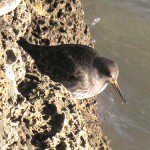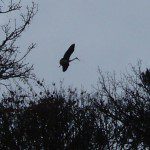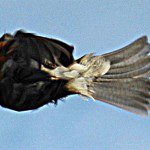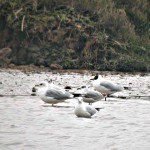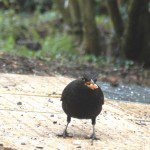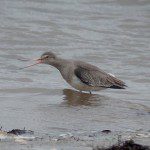Axe Estuary Birds No 151 February 28th 2011
NB: The following is reproduced by kind permission of Axe Estuary Birds. Full credit goes to the team that produces the newsletter (see the bottom of the post for specific details). Photographs are credited throughout the text although we are working to preserve the original layout wherever possible in the future.
The Birds
There have been 36 Mute Swans on the field near Stedcombe, together with a Bewick, and many Shelduck. Donald Campbell saw 145 Scoter and a couple of Fulmars from Haven Cliff while helping to clear the new path there, and later an Otter flushed a Woodcock in the Undercliff.
Alan Salter saw no less than 50 Snipe fly up from Colyford Marsh on 13th March, possible put up by a Raptor, and Ian Waite reports 10 pairs of Fulmar off Seaton Hole on 23rd and a male Black Redstart, a dozen Velvet Scoter and a Peregrine.
Grey Herons have returned to their now traditional heronry in a private garden in Axmouth, and this morning , 25th, there were at least four pairs busy around the nests. The Little Egrets have not joined them yet, but hopefully will before long. Watch this space.
At Colyford Common, there were more of the same with dreary days of low cloud, mist and rain relieved by 2 gloriously sunny days, especially the 19th but there were hardly any records that day. At the start of the half term week there were many visitors, 15 were counted in thirty minutes late Sunday afternoon (20th).
Mute Swans, ALF and ALU continued to graze near the boardwalk at Colyford Common, unconcerned by passing visitors to the hide. The ‘Stedcombe’ Mute Swans peaked at 36 including three immature birds; the Bewick’s Swan and the Greylag Goose were with them on the 14th. Canada Goose numbers were down from numbers in the thirties in previous weeks to a maximum of 16 on the marsh this week. Wigeon peaked at 200 (17th and 20th), the largest Teal count was 56 on the scrape on 14th with 3 Shoveler there on the same day; the maximum Shelduck count was 12 on 20th on the marsh. As so often happens, Mallard were hardly noticed! Little Egrets were again absent (in 2010, up to four were present throughout February) and only 2 Grey Herons were noted. There were several counts of 200 or more Lapwing on the marsh with 450 noted in flight on 19th. 30 Black-tailed Godwits were seen on the marsh on 14th, 200 Curlew were there on the same day and 10 Dunlin were seen in flight on 19th. There were no records of Sandpipers. As usual at the moment, passerines were scarcely recorded so a count of 20 Linnets on the reserve on 14th and 3 Rock Pipits there on 19th were nice to see. The only Meadow Pipit was one on Stafford Marsh on 17th.
Seaton Marshes log book shows a goodly array of ducks -17 Shelduck, 86 Wigeon, 24 Mallard, 22 Teal and four Shoveler. No less than 24 Pheasant were noted, and eight Heron, about 500 Lapwing and 44 Black-tailed Godwit.
Steve Waite had a few looks along the Estuary on Friday 25th, the weather conditions had been pretty good for ‘gulling’. The best he could muster though (so far anyway!) were two Med Gulls, including presumably the same first-winter as the other day… Have also noted c200 Common and 26 Lesser Black-backed Gulls (one or two looking quite black-backed, but also one very pale second-winter bird).
Ringing
Neil Croton feels we may be interested in the history of a Black Tailed Godwit, ringed by the group. It was ringed by AERG on the 3rd Oct 08 as a juvenile, and stayed on the estuary until 1st March 09. It was then noted at Otterton on 29th March that year, then returned to the Axe from the 30th right through April. In May it was seen at Bowling Green Marsh, and on 14th September that year was spotted at Penistin, France. It returned to the Axe in March 2010, and again in February 2011. It looks like this bird passes through and stops off on the Axe in the early spring and is wintering much further south.
The group took part in the Wild and Wet Weekend on Saturday at Colyford Common, in the morning it certainly was wet and wild! Nevertheless in between the heavy showers and windy gusts we did catch 11 birds, which were very much appreciated by the public who watched the activities from the new field centre. The children really did enjoy the opportunity to see the birds close up. The birds caught were Coal Tit 1, Dunnock (2), Long-tailed Tit 2, Goldcrest 2, Wren 1 and Robin 3 (1).
News from Holyford Woods
Signs of spring are developing with leaps and bounds, with many more bird calls. Now the ramsons are up. Walking on those on the path edge releases that loved or hated pungent smell of garlic. Beneath a tree root the first early purple orchid is peeping out, its juicy leaves already nibbled by some little creature. Several times over the last two months in various places I have caught the strong scent of a travelling dog fox, and today it came from around one of the badger setts which pleased Paco. Not only is there a frequently used badger latrine beside my seat, but there are 2 long tunnels into the bramble thicket nearby, also of interest to Paco, so maybe a badger rests there. Seated there, at still and quiet times I can often hear the waves crashing on Seaton beach. On the pond there are approximately 39 blobs of frog spawn, and now there is a lot of frog activity along the edge of Top Pool, so more to come there. Today, from the log seat I watched two Long Tailed Tits feeding through the willows, and two Goldcrests came down from the trees to drink. The two pairs of Moorhen and Mallard Duck are frequently seen dabbling in the patches of clear water among the temporarily dead parrot feather weed. Also today there were three Greater Spotted Woodpeckers calling and chasing around in the oak trees above me, then eventually two flew off, leaving the remaining one drumming furiously. Jean Kreiseler
The Trivia
Roger Boswll writes “I was very interested in Karen’s image of the yawning BTG. The reason being that I had photographed a Purple Sandpiper on the Cobb that I thought had a deformed bill. After I put it into Birdforum I got a reply saying it was probably an example of rhynchokinesis.”
Karen Woolley says “ The Godwit in my photo is indeed showing rhynchokinesis, apparently it’s most prevalent in waders such as godwits/dowitchers. It isn’t an affliction just the ability to flex the end of the bill. Amazing what photos can show up isn’t it?” Makes me wonder if it is recent evolution in action – or a past ability fading?
Simon Wakely took this picture of a male Blackbird with a peanut, surely not their usual choice of food , and a Robin making a good imitation of a shuttle cock! He also says “Whitford has come alive, Bumble, & Honey bees on our crocus. Loads of Ladybirds, our birds are showing signs of pairing up, Great Spotted Woodpeckers drumming, Green Woodpeckers calling in our Apple trees, and plenty of Jays.
Garden Bird Watch
No doubt many of you took part in the RSPB Big Garden Birdwatch again this year, and you may remember that we have done something similar, on a much smaller scale, for the last few years. And we plan to do it again this year over the weekend of 5th and 6th March. There is a suitable form attached to this email. It doesn’t matter how far away from the Axe Valley you are – entries from Colyford or California, Botswana or Brisbane all equally welcome. There was not a huge response last year – lets hope for more this year.
Birds for Beginners
For the new season’s Birds for Beginners sessions, it is planned to have a “Guide in the Hide” every Friday from 10.00 am. At the moment the sessions will start at either The Island Hide or Colyford Common Hide, and a notice will be posted to indicate which one. Then from 12.30pm the guide will move to Seaton Marshes Hide.
.
This twice-monthly email newsletter is freely available to anyone who would like it, as is a periodic one about the activities of the East Devon Local Group of the Devon Wildlife Trust. Just send me an email with Axe Estuary Birds and/or East Devon DWT in the subject line. Also, for those without a computer, I will send a copy by post if you would like to send me some stamps.
Thanks to those who keep me informed. Please continue to tell me of any unusual, interesting or amusing sightings, and what is about locally, and send any photos you would like to share.
Mike, Jean, and David. (and many others!) davidwalters@eclipse.co.uk. tel. 01297 552616 Mobile 0779 1541 744.

